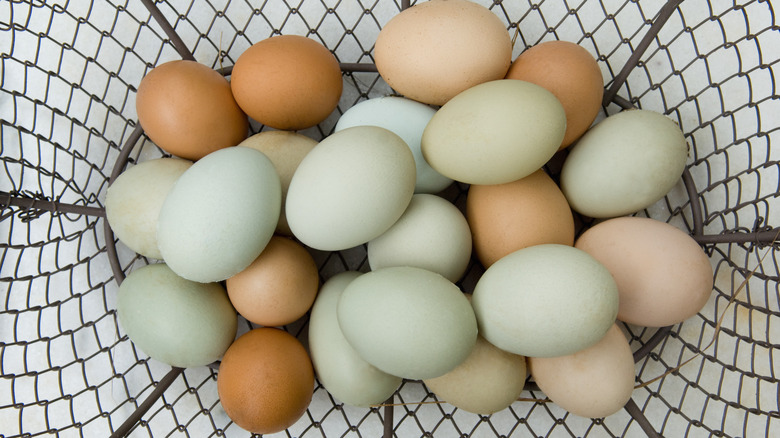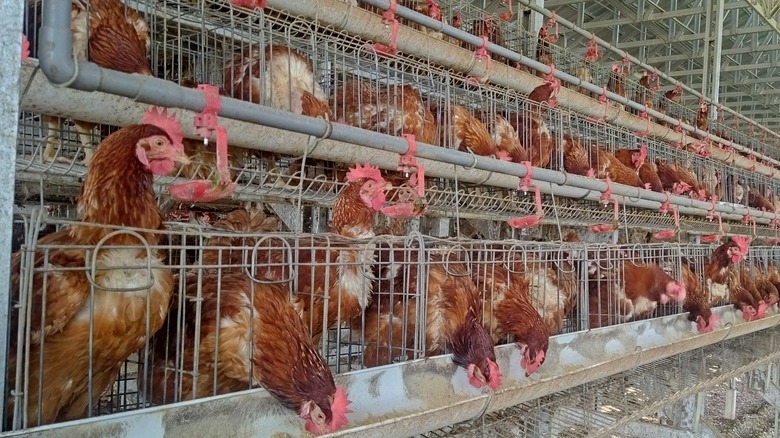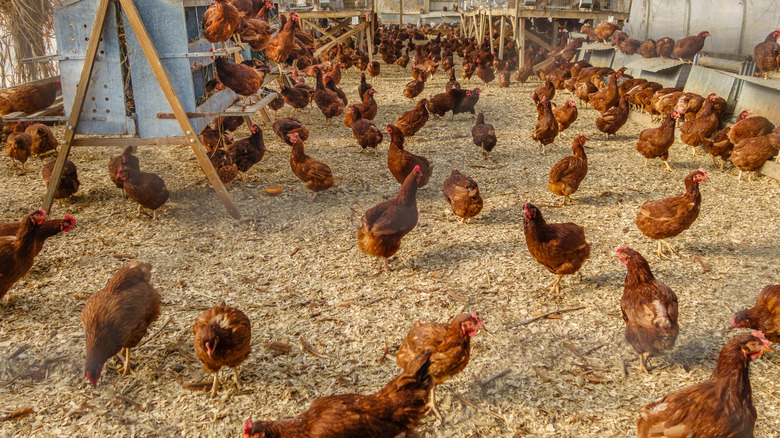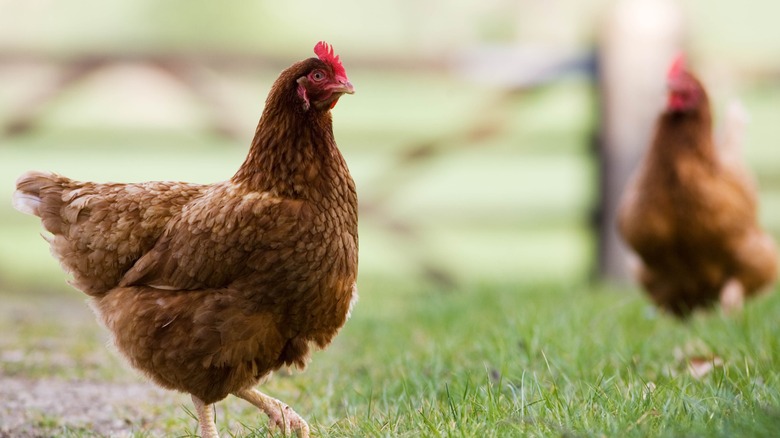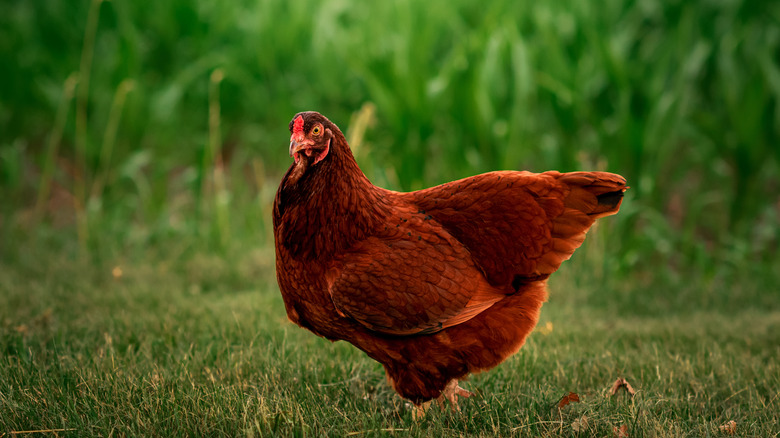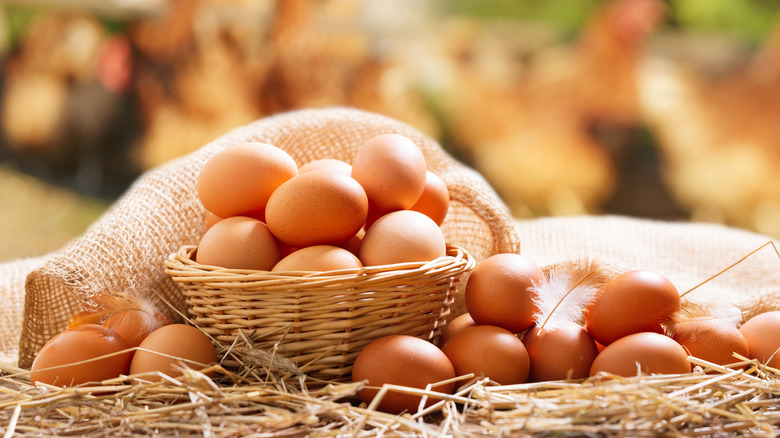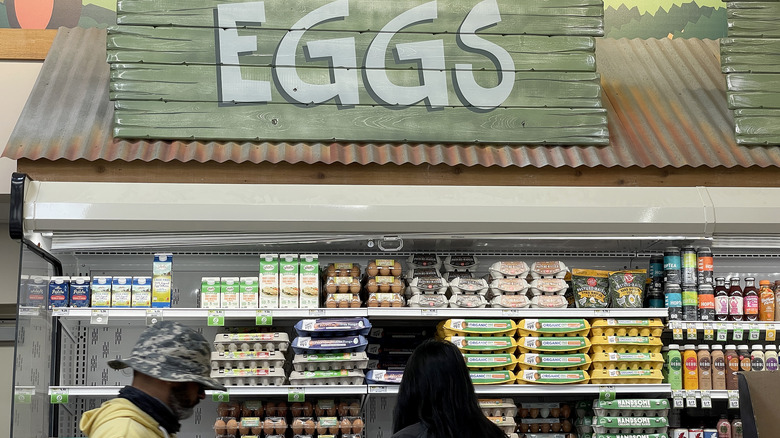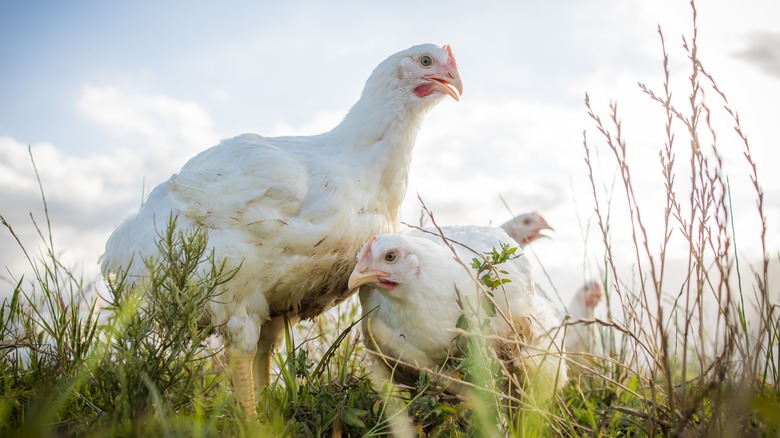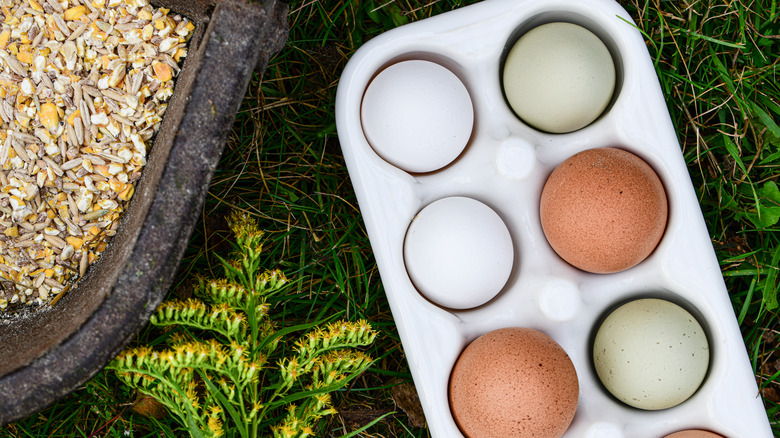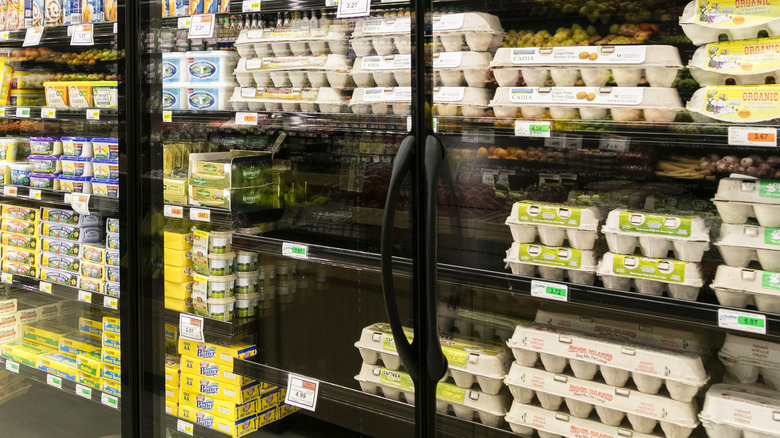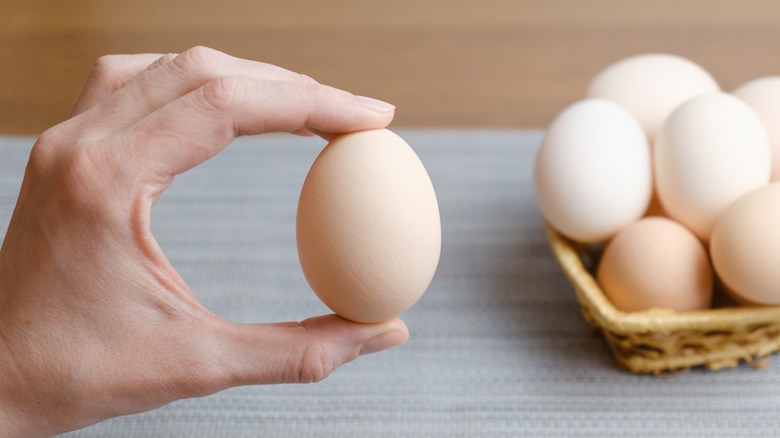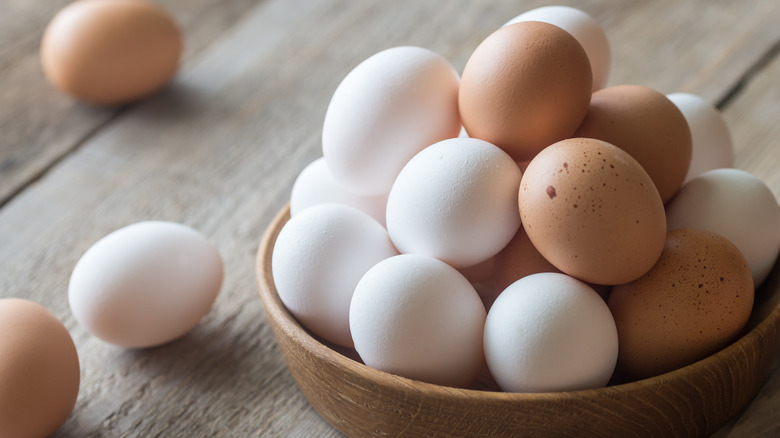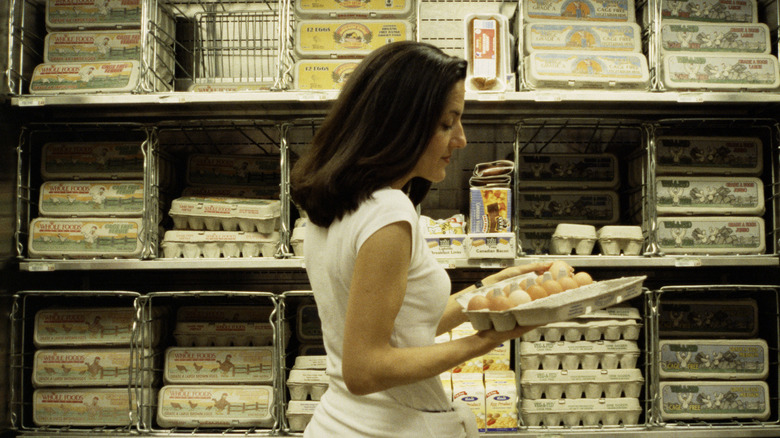What Eggs Should You Really Be Buying?
Organic, free-range, cage-free, pasture-raised, hormone-free, vegetarian ... the list goes on and on. The growing desire for specialty eggs and the tireless spurring of animal rights groups the world over have sent the egg industry into a mad scramble to meet ever-changing standards and demands. Labels from the USDA and third-party certification services seek to inform the consumer of the size and grade of their eggs, as well as the nutritional content and the animal welfare methods used in getting your eggs into the carton.
But what do these labels really mean? Some labels are well-meaning, and some are just a bunch of marketing hype. So what does it all mean, and what do you need to look for to make sure you're getting the best of the bunch? Here's how you can figure out which eggs you should really be buying the next time you're at the grocery store.
Battery caging
Banned in the European Union since 2013, battery caging of hens was once considered an exciting innovation in the egg industry. Egg production, which used to be a small-scale farm operation, became an efficient factory machine, providing low-cost eggs to a global market that was hungry for $1.99 Croissan'wiches and chilled cartons of egg whites. But who paid the price for all those cheap eggs? The chickens.
Consumers, ever more curious and vocal about the origin of their food, couldn't ignore the egg industry. Battery caging has been "condemned by every animal protection group in the world," according to the Huffington Post. There are videos out there that are enough to make you put that Egg McMuffin down and declare yourself a vegan. The two-year life span of a typical battery-caged hen isn't pretty and includes living stacked in a cage packed with as many as ten hens, with no ability to walk or spread her wings. Hens' sensitive beaks are sheared without the use of painkillers, and they often live with atrophied muscles and broken bones, housed with cage mates who have already died from dehydration. Denied the ability to nest, forage, or dust-bathe (all primal instincts to a hen), caged hens lead sad lives. It is a cruel fate for an animal that is believed to be at least as smart as a kindergartener, according to the University of Bristol's report that shows chickens have "complex capacities with regard to empathy, navigation, communication, social interaction, transitive inference (figuring out that if A is greater than B, and B is greater than C, then A is greater than C), understanding 'object permanence,' and even learning basic arithmetic."
Public outcry against this barbaric practice has not fallen on deaf ears, with corporations like Burger King, McDonald's, General Mills, Sodexo, Aramark, and Compass Group switching to cage-free eggs or vowing to switch in coming years. California's residents voted to make all California eggs cage-free by 2015. This sea of change has led to many producers beginning the expensive process of converting their operations to meet voluntary labeling guidelines, which, for a fee, can be granted by the USDA's Agricultural Marketing Service.
Cage-free
Cage-free. Sounds pretty good, right? Imagine happy chickens roaming in the sunshine, enjoying their liberty and each other's company ... the exact image that most companies want you to conjure when you see this label on a carton of eggs. What cage-free means, however, is far different, but it's still a vast improvement from the previous industry norm of battery caging. Cage-free is a voluntary label, regulated by the Agricultural Marketing Service, that audits for advantages like perching and dust-bathing areas. Cage-free hens, while not caged, do not necessarily have access to the outdoors but should have room to roam about and spread their wings. They often live in flocks of hundreds, and there is no standard for a cage-free hen's diet.
Cage-free does not mean cruelty-free. Many cage-free producers practice beak shearing and use the "forced molting" technique of starving older hens to get one last round of eggs from them. Thankfully, most are phasing out the practice of "culling" male chicks by tossing them live into meat grinders. Consider cage-free to be a step in the right direction, but if you're truly looking to vote with your dollar at the supermarket, you can do much better.
Free-range
Free-range is another marketing label that is voluntary for producers. The USDA's Agricultural Marketing Service designates that free-range hens must be housed in a building similar to that of cage-free hens but with access to an outdoor area. They do not require that the outdoor area be of any particular size or quality. Poultry-advocacy organization United Poultry Concerns describe conditions at a free-range facility: "Typically, 2,000 to 20,000 or more hens — each hen having one square foot of living space the size of a sheet of paper — are confined in a shed with little or no access to the outdoors. If the hens can go outside, the exit is often very small, allowing only the closest hens to get out. And the 'range' may be nothing more than a mudyard saturated with manure."
Like cage-free birds, there are no requirements for the quality or type of feed for free-range birds, and many producers still employ the methods of beak shearing, forced molting, and other practices that would not be considered cruelty-free. At the end of the day, free-range doesn't really add up to much more than cage-free in the way of quality of life for a factory-farmed chicken.
Pasture-raised
Pasture-raised eggs (not to be confused with pasteurized!) are laid by hens that are permitted a large amount of outdoor access where they can forage and feed on grass, grubs, and seeds the way they would in their natural environment. Shelter is provided for nesting and inclement weather. While pasture-raised eggs typically come from smaller farms or companies, there are no definitive government standards for pasture-raised operations, with a producer voluntarily submitting to twice-yearly inspections from the Agricultural Marketing Service. If you can find pasture-raised eggs at your supermarket, they're a fantastic choice. Some even believe they're more nutritious than their factory-fed counterparts.
If your local store doesn't carry them, ask them to. Better yet, find a farmer's market or local farmer where you can buy fresh eggs that may come in a wide array of shell colors and sizes. Though they may not be officially labeled as such (the label is not prohibitively expensive, but smaller farms may have a hard time keeping up with the record keeping required to maintain different certifications), you can ask the farmer firsthand what goes into the care of the farm's hens.
Organic
When it comes to knowing exactly what your food ate, the organic label is the gold standard in the industry. Eggs carrying the USDA Organic seal come from free-range hens with access to the outdoors and sunlight. The National Organic Program's strict rules dictate that hens are fed only certified organic, non-GMO feed and receive preventative health care without the use of antibiotics (except in cases of extreme outbreaks). Organic does not mean pasture-raised, however. Hens from organic farms with pasture access must also be labeled as such. While the life of an organic hen meets animal welfare standards that far exceed those of a caged hen, there are large-scale organic producers who do not meet ethical requirements that are important to many organic consumers, with many practicing beak shearing or continuing to purchase their chicks from hatcheries that still cull their male chicks, though this practice is slowly being phased out. Want to know how your favorite brand stacks up? The Cornucopia Institute's exhaustive list grades over 100 brand names and lets you know where you can buy them. If you can't always make it to a local farmer, aim for an organic, pasture-raised egg that scores high on the Cornucopia Institute's list.
California Shell Egg Food Safety Compliant
If you reside in California, you may have noticed a new egg label on supermarket shelves. The California Shell Egg Food Safety Compliant or CA SEFS Compliant label is the result of a 2008 ballot called Proposition 2 that passed with 64 percent approval. Prop 2 mandated that as of January 2015, any egg-laying hen in the state of California have enough room to stand, lie down, turn around, and fully extend her wings. The California Department of Food and Agriculture followed Prop 2 up with their own egg safety ruling, which went into effect in July 2013 and required all eggs produced or sold in California to come from flocks that have undergone heightened salmonella testing and vaccination. It also allowed all egg-laying hens a minimum of 116 square inches of floor space to move around.
Despite a great deal of pushback to Prop 2 from the egg industry, which cited rocketing prices for both producers and consumers, the resulting rulings have provided a surge of momentum in the movement for cage-free eggs. United Egg Producers, the largest egg industry group in the U.S., laid down their arms when confronted with a November 2016 ballot in Massachusetts which seeks to bar the in-state sale of meat or eggs from caged animals.
Voluntary animal welfare labels
A number of reputable (and some not so reputable) third-party organizations exist that, for a fee, will inspect and certify an egg producer's facility or farm to ensure that a certain level of humane requirements are being met. Some may be familiar.
American Humane Certified standards set forth specific requirements for the amount of space given to all types of egg-laying hens from caged to pastured. As of 2014, this organization was responsible for the welfare of more than one billion animals; it bills itself as "the nation's oldest and largest third-party animal welfare auditing program." The group has come under fire from animal rights organizations that point to a hidden camera scandal at food giant Foster Farms, showing workers displaying acts that are anything but humane.
The Certified Humane label, brought to you by Humane Farm Animal Care (HFAC), is supported by animal advocates like the ASPCA. It certifies eggs that come from egg-laying hens who are cage-free, free-range, or pasture-raised, and enjoy a minimum of standards that far exceed Agricultural Marketing Service requirements, like more space, free access to quality food and water, standards in air quality, and increased outdoor access. Nevertheless, this label also faces its fair share of criticism from activists, who believe it kowtows to the industry factory farms it certifies.
The Global Animal Partnership (GAP) was created in cooperation with animal welfare pioneer Temple Grandin and is the certification system used at Whole Foods markets. The GAP system is unique in the industry, as it employs a five-step rating guide to designate a producer's welfare standards. Critics argue that it's far too easy for a producer to get a 1 or even 2 rating, which are considered already to be the minimum in basic factory farm industry practices.
The Animal Welfare Institute is possibly the most universally regarded third-party system and uses the Animal Welfare Approved label. Generally considered to have the highest animal welfare standards, eggs with this label come from small flocks that have plenty of access to pasture and healthcare. The AWI is open about its goal of abolishing factory farms and is the only animal welfare certifier to ban the practice of beak shearing for chickens. If you can find (and afford) organic, pasture-raised eggs that also display the AWA label, you've hit the supermarket egg jackpot.
Vegetarian-fed
You've no doubt seen eggs that are vegetarian-fed by now, and perhaps you've even been suckered in by the implied promise of a healthier, better-quality egg. You wouldn't be alone: many of the largest organic egg producers proudly boast this label, and the organic-minded public has been literally eating it up. There is just one little problem, and her name is Mother Nature. You see, chickens are omnivores, not vegetarians, by nature.
Chickens love to eat bugs, worms, and all manner of creepy crawlies (sometimes even snakes and small mice!) that they scratch up and peck as they forage in pasture. When chickens are denied this animal protein in their diets, as they are in vegetarian-fed operations that feed them a grain-based diet of mostly corn and soy, they are denied an essential amino acid called methionine (MET), which their bodies need to thrive. Without it, chickens' health rapidly deteriorates, and chickens will desperately do whatever they need to do to get their methionine fix, including trying to eat other birds' feathers, which can easily turn into cannibalism.
Producers of traditional, non-organic eggs supplement their chicken feed with synthetic MET. Organic producers, however, find themselves in a Catch-22 when it comes to how to deliver the essential nutrient to their flocks. Synthetic MET is severely limited by organic standards, as are controversial animal by-products, which contain natural MET. Feeding the chickens a higher ratio of plant proteins, which do contain necessary MET, has the undesirable effect of damaging the chickens' digestive systems and adding excessive environmentally unfriendly nitrogen to the air. The industry is currently researching natural sources of MET, with many organic farmers legally disputing the limits on synthetic MET. The lack of an acceptable means of getting the proper amount of MET to their chickens means some producers don't supply it at all, an act that is seen as cruel. Ernie Peterson of Cashton Farm Supply told the Washington Post: "The birds are suffering. It's not right that we are forcing this diet on them. We have people who are supposed to worry about animal welfare. Where are they? This is cruelty."
So what's the answer? Say it with me: organic, pasture-raised eggs! If your local store doesn't carry them, ask them to. Better yet, find yourself a local farmer to support.
Labels that don't really mean much
Is your head already spinning with how to possibly keep up with the dizzying array of egg labels out there? Well there are plenty more where those came from, and some of them are just a bunch of hype.
"Natural," "All Natural," or "Farm Fresh": Pure marketing ploys. In short, these labels mean bupkis.
"Hormone-free": While technically true, this is a case of an egg producer simply bragging about something that's already required. The USDA does not permit the use of any hormones in egg-laying hens.
"Omega-3 enriched": Sure, producers can feed flocks extra flaxseed to their omega-3-filled heart's content, but you're probably better off getting this fatty acid from other sources like fish and nuts.
"No Antibiotics Added": Unlike chickens raised for meat, egg-laying hens are only rarely given antibiotics, so while this claim may be factual, it's not really something to be too excited about.
What about sizes and grades?
The USDA provides a grading service that is voluntary to producers to determine an egg's quality. Grade AA eggs are young eggs distinguished by their near-perfect shells, as well as distinctly separated whites (albumen) and yolks. Grade A eggs, typically found in stores, are similar in appearance to grade AA, but are characterized by their slightly looser whites. Grade B eggs are older eggs with thin whites and wider yolks that are ideal for hard-boiling. Eggs can change grades by aging, even while sitting in your fridge. Eggs that don't make one of these grades are sent on to be made into a wide variety of egg products.
Egg size listings are also voluntary and are judged separately from their grade. They are listed merely as a guide and do not indicate quality. Sizes start with Jumbo (30 ounces per dozen), all the way down to the rarely seen Pee Wee (15 ounces per dozen).
The USDA system also provides inspection services for facilities and requires all eggs with its seal be sterilized before packaging.
Brown eggs or white eggs?
It's OK, you can admit it if you think that brown eggs are healthier than white or that organic eggs are always brown. The truth will make any farmer chuckle.
Different colors of eggs simply come from different breeds of hens, with shell color sometimes determined by the color of the hen's earlobes. Backyard chicken farmers enjoy eggs in shades ranging from blue to green to pinkish. As for the eggs you buy at the grocery store, when it comes to color alone, there is no nutritional difference in what lies underneath the shell. So why are brown eggs more expensive? In some cases, it's because public opinion has allowed them to be, but it's also because brown eggs tend to be larger.
Final recommendations
It would be easy to be overwhelmed by all the information out there when it comes to egg labels. Here's a summary, in order of preference, for the next time you want to whip up an omelette.
If you can, buy eggs from pasture-raised hens direct from a farm or farmer's market. When at the store, look for organic eggs from pasture-raised hens and earn bonus points for finding the Animal Welfare Approved label. If you can't find those, look for organic, free-range eggs, preferably non-vegetarian. Finally, traditional eggs that bear the seal of a reputable, third-party animal welfare certifier will probably be better than eggs bearing no certifications or seals.
Again, if you don't find what you want at your local store, ask for it. Consumers drive buying decisions. Buy the best that you can afford. And remember, the way you spend your dollar at the supermarket is a vote for the kinds of foods that you want to have available to you.
